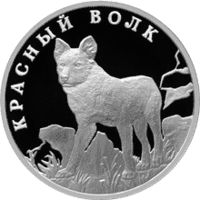Dhole
{| class="infobox biota" style="text-align: left; width: 200px; font-size: 100%" |-
! colspan=2 style="text-align: center; background-color: rgb(235,235,210)" | Dhole
|-
| colspan=2 style="text-align: center" |  |-
|-
|- style="text-align: center; background-color: rgb(235,235,210)"
! colspan = 2 |
|-
| colspan = 2 |
|-! colspan = 2 |
|-
| colspan = 2 |
|-
! colspan=2 style="min-width:15em; text-align: center; background-color: rgb(235,235,210)" | Scientific classification ![]() |-
|Domain:
|Eukaryota
|-
|Kingdom:
|Animalia
|-
|Phylum:
|Chordata
|-
|Class:
|Mammalia
|-
|Order:
|Carnivora
|-
|Family:
|Canidae
|-
|Subfamily:
|Caninae
|-
|Tribe:
|Canini
|-
|Genus:
|Cuon
|-
|Domain:
|Eukaryota
|-
|Kingdom:
|Animalia
|-
|Phylum:
|Chordata
|-
|Class:
|Mammalia
|-
|Order:
|Carnivora
|-
|Family:
|Canidae
|-
|Subfamily:
|Caninae
|-
|Tribe:
|Canini
|-
|Genus:
|Cuon
Hodgson, 1838
|-
| Species:
|
|-
|-
|-
! colspan=2 style="text-align: center; background-color: rgb(235,235,210)" | Binomial name
|-
| colspan=2 style="text-align: center" | Cuon alpinus
|- style="text-align: center; background-color: rgb(235,235,210)"
|-
|-
|-
|-
|-
|-
|-
|- ! colspan=2 style="text-align: center; background-color: rgb(235,235,210)" | Subspecies |- | colspan=2 style="text-align: left" |
- C. a. adjustus
- C. a. alpinus
- C. a. fumosus
- C. a. hesperius
- C. a. laniger
- C. a. lepturus
- C. a. sumatrensis
- † C. a. antiquus
- † C. a. caucasicus
- † C. a. europaeus
|-
|-
| colspan=2 style="text-align: center" |  |-
| colspan=2 style="text-align: center; font-size: 88%" | dhole range
|-
|-
| colspan=2 style="text-align: center; font-size: 88%" | dhole range
|-
|- ! colspan=2 style="text-align: center; background-color: rgb(235,235,210)" | Synonyms |- | colspan=2 style="text-align: left" | Canis alpinus |-
|}
The dhole (
The dhole is a highly social animal, living in large clans without rigid
It is listed as
Etymology and naming
The etymology of "dhole" is unclear. The possible earliest written use of the word in English occurred in 1808 by soldier Thomas Williamson, who encountered the animal in Ramghur district, India. He stated that dhole was a common local name for the species.[13] In 1827, Charles Hamilton Smith claimed that it was derived from a language spoken in 'various parts of the East'.[14]
Two years later, Smith connected this word with
Other English names for the species include Asian wild dog, Asiatic wild dog,[19] Indian wild dog,[17] whistling dog, red dog,[10] red wolf,[6] and mountain wolf.[20]
Taxonomy and evolution
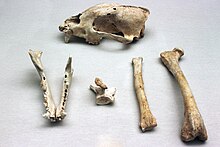
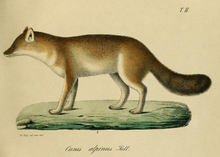
Canis alpinus was the
Canis primaevus was a name proposed by
The first study on the origins of the species was conducted by paleontologist Erich Thenius, who concluded in 1955 that the dhole was a post-Pleistocene descendant of a golden jackal-like ancestor.
The vast Pleistocene range of this species also included numerous islands in Asia that this species no longer inhabits, such as
A single record of the dhole is known from North America. This consists of a jaw fragment and teeth of Late Pleistocene age found in San Josecito Cave in northeast Mexico, dating to around 27-11,000 years ago.[40]
| Phylogenetic tree of the wolf-like canids with timing in millions of years[a] | |||||||||||||||||||||||||||||||||||||||
|
Dholes are also known from the Middle and Late Pleistocene fossil record of Europe.
The dhole's distinctive morphology has been a source of much confusion in determining the species' systematic position among the Canidae. George Simpson placed the dhole in the subfamily Simocyoninae alongside the African wild dog and the bush dog, on account of all three species' similar dentition.[42] Subsequent authors, including Juliet Clutton-Brock, noted greater morphological similarities to canids of the genera Canis, Dusicyon and Alopex than to either Speothos or Lycaon, with any resemblance to the latter two being due to convergent evolution.[5]
Some authors consider the extinct Canis
Admixture with the African wild dog
In 2018, whole genome sequencing was used to compare all members (apart from the black-backed and side-striped jackals) of the genus Canis, along with the dhole and the African wild dog (Lycaon pictus). There was strong evidence of ancient genetic admixture between the dhole and the African wild dog. Today, their ranges are remote from each other; however, during the Pleistocene era the dhole could be found as far west as Europe. The study proposes that the dhole's distribution may have once included the Middle East, from where it may have admixed with the African wild dog in North Africa. However, there is no evidence of the dhole having existed in the Middle East nor North Africa,[49] though the Lycaon was present in Europe during the Early Pleistocene, with its last record in the region dating to 830,000 years ago. Genetic evidence from the Sardinan dhole suggests that both Sardinian and modern dholes share ancestry from the Lycaeon lineage, but this ancestry is significantly higher in modern dholes than in the Sardinian dhole.[48]
Subspecies
Historically, up to ten subspecies of dholes have been recognised.[50] As of 2005[update], seven subspecies are recognised.[51][52]
However, studies on the dhole's
In the absence of further data, the researchers involved in the study speculated that Javan and Sumatran dholes could have been introduced to the islands by humans.
| Subspecies | Image | Trinomial authority | Description | Distribution | Synonyms |
|---|---|---|---|---|---|
| C. a. adjustus Burmese dhole,[47] Indian dhole | 
|
Pocock, 1941[47] | Reddish coat, short hair on the paws and black whiskers[11] | Northeastern India and south of the Ganges River, northern Myanmar[11] | antiquus (Matthew & Granger, 1923), dukhunensis (Sykes, 1831) |
| C. a. alpinus Ussuri dhole[6]
( nominate subspecies )
|
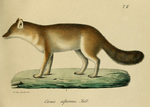
|
Pallas, 1811[22] | Thick tawny red coat, greyish neck and ochre muzzle[11] | East of the eastern Sayan Mountains, eastern Russia, northeastern Asia[11] | –
|
| C. a. fumosus[56] | Pocock, 1936[56] | Luxuriant yellowish-red coat, dark back and grey neck[11] | Western Sichuan, China and Mongolia. Southern Myanmar, Thailand, Laos, Cambodia, Vietnam, Malaysia and Java, Indonesia[11] | infuscus (Pocock, 1936), javanicus (Desmarest, 1820) | |
| C. a. hesperius Tien Shan dhole[6] | 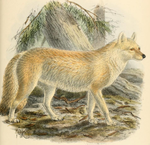
|
Afanasjev and Zolotarev, 1935[57] | Long yellow tinted coat, white underside and pale whiskers[11] Smaller than C. a. alpinus, with wider skull and lighter-coloured winter fur.[6] | Eastern Russia and China[11] | jason (Pocock, 1936) |
| C. a. laniger[56] | Pocock, 1936[56] | Full, yellowish-grey coat, tail not black but same colour as body[11] | Southern Tibet, Himalayan Nepal, Sikkim, Bhutan and Kashmir[11] | grayiformis (Hodgson, 1863), primaevus (Hodgson, 1833) | |
| C. a. lepturus[56] | 
|
Heude, 1892[58] | Uniform red coat with thick underfur[11] | South of the Yangtze River, China[11] | clamitans (Heude, 1892), rutilans (Müller, 1839), sumatrensis (Hodgson, 1833) |
| Sumatran dhole and Javan dhole C. a. sumatrensis[59] | 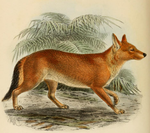
|
Hardwicke, 1821[60] | Red coat and dark whiskers[11] | Sumatra, Indonesia[11] Its range is highly fragmented with multiple protected areas in Sumatra and Java.[1] |
Characteristics


The dhole's general tone of the fur is reddish, with the brightest hues occurring in winter. In the winter coat, the back is clothed in a saturated rusty-red to reddish colour with brownish highlights along the top of the head, neck and shoulders. The throat, chest, flanks, and belly and the upper parts of the limbs are less brightly coloured, and are more yellowish in tone. The lower parts of the limbs are whitish, with dark brownish bands on the anterior sides of the forelimbs. The muzzle and forehead are greyish-reddish. The tail is very luxuriant and fluffy, and is mainly of a reddish-ocherous colour, with a dark brown tip. The summer coat is shorter, coarser and darker.[6] The dorsal and lateral guard hairs in adults measure 20–30 mm (0.79–1.18 in) in length. Dholes in the Moscow Zoo moult once a year from March to May.[10] A melanistic individual was recorded in the northern Coimbatore Forest Division in Tamil Nadu.[61]
The dhole has a wide and massive skull with a well-developed sagittal crest,[6] and its masseter muscles are highly developed compared to other canid species, giving the face an almost hyena-like appearance.[62] The rostrum is shorter than that of domestic dogs and most other canids.[10] It has six rather than seven lower molars.[63] The upper molars are weak, being one third to one half the size of those of wolves and have only one
In appearance, the dhole has been variously described as combining the physical characteristics of the
Distribution and habitat
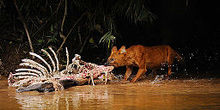

The dhole can be found in Tibet and possibly also in North Korea and Pakistan. It once inhabited the alpine steppes extending into Kashmir to the Ladakh area.[1] In Central Asia, the dhole primarily inhabits mountainous areas; in the western part of its range, it lives mostly in alpine meadows and high-montane steppes, while in the east, it mainly ranges in montane
In the Pamir Mountains of southern Kyrgyzstan, the presence of the dhole was confirmed in 2019.[65]
The dhole might still be present in the Tunkinsky National Park in extreme southern Siberia near Lake Baikal.[66] It possibly still lives in the Primorsky Krai province in far eastern Russia, where it was considered a rare and endangered species in 2004, with unconfirmed reports in the Pikthsa-Tigrovy Dom protected forest area; no sighting was reported in other areas since the late 1970s.[67][page needed] Currently, no other recent reports are confirmed of dhole being present in
One pack was sighted in the Qilian Mountains in 2006.[69] In 2011 to 2013, local government officials and herders reported the presence of several dhole packs at elevations of 2,000 to 3,500 m (6,600 to 11,500 ft) near
In China's Yunnan Province, dholes were recorded in Baima Xueshan Nature Reserve in 2010–2011.[72] Dhole samples were obtained in Jiangxi Province in 2013.[73] Confirmed records by camera-trapping since 2008 have occurred in southern and western Gansu province, southern Shaanxi province, southern Qinghai province, southern and western Yunnan province, western Sichuan province, the southern Xinjiang Autonomous Region and in the Southeastern Tibet Autonomoous Region.[74] There are also historical records of dhole dating to 1521–1935 in Hainan Island, but the species is no longer present and is estimated to have become extinct around 1942.[38]
The dhole occurs in most of India south of the Ganges, particularly in the Central Indian Highlands and the
In 2011, dhole packs were recorded by camera traps in the Chitwan National Park.[75] Its presence was confirmed in the Kanchenjunga Conservation Area in 2011 by camera traps.[76] In February 2020, dholes were sighted in the Vansda National Park, with camera traps confirming the presence of two individuals in May of the same year. This was the first confirmed sighting of dholes in Gujarat since 1970.[77]
In Bhutan, the dhole is present in Jigme Dorji National Park.[78][79]
In Bangladesh, it inhabits forest reserves in the Sylhet area, as well the Chittagong Hill Tracts in the southeast. Recent camera trap photos in the Chittagong in 2016 showed the continued presence of the dhole.[80] These regions probably do not harbour a viable population, as mostly small groups or solitary individuals were sighted.[1]
In
Its range is highly fragmented in the
In
In 2019, scat samples collected in the Bek-Tosot Conservancy in Kyrgyzstan confirmed the continued presence of dholes in the area. This was the first record of dholes from the country in almost three decades.[65]
A disjunct dhole population was reported in the area of
Ecology and behaviour
Dholes produce whistles resembling the calls of red foxes, sometimes rendered as coo-coo. How this sound is produced is unknown, though it is thought to help in coordinating the pack when travelling through thick brush. When attacking prey, they emit screaming KaKaKaKAA sounds.[91] Other sounds include whines (food soliciting), growls (warning), screams, chatterings (both of which are alarm calls) and yapping cries.[92] In contrast to wolves, dholes do not howl or bark.[6]
Dholes have a complex body language. Friendly or submissive greetings are accompanied by horizontal lip retraction and the lowering of the tail, as well as licking. Playful dholes open their mouths with their lips retracted and their tails held in a vertical position whilst assuming a play bow. Aggressive or threatening dholes pucker their lips forward in a snarl and raise the hairs on their backs, as well as keep their tails horizontal or vertical. When afraid, they pull their lips back horizontally with their tails tucked and their ears flat against the skull.[93]
Social and territorial behaviour
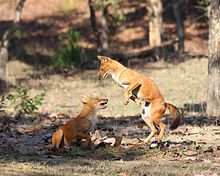
Dholes are more social than
Dholes are far less
Denning
Four kinds of den have been described; simple earth dens with one entrance (usually remodeled striped hyena or porcupine dens); complex cavernous earth dens with more than one entrance; simple cavernous dens excavated under or between rocks; and complex cavernous dens with several other dens in the vicinity, some of which are interconnected. Dens are typically located under dense scrub or on the banks of dry rivers or creeks. The entrance to a dhole den can be almost vertical, with a sharp turn three to four feet down. The tunnel opens into an antechamber, from which extends more than one passage. Some dens may have up to six entrances leading up to thirty metres (100 ft) of interconnecting tunnels. These "cities" may be developed over many generations of dholes, and are shared by the clan females when raising young together.[98] Like African wild dogs and dingoes, dholes will avoid killing prey close to their dens.[99]
Reproduction and development

In India, the
The
Pups are suckled at least 58 days. During this time, the pack feeds the mother at the den site. Dholes do not use rendezvous sites to meet their pups as wolves do, though one or more adults will stay with the pups at the den while the rest of the pack hunts. Once weaning begins, the adults of the clan will regurgitate food for the pups until they are old enough to join in hunting. They remain at the den site for 70–80 days. By the age of six months, pups accompany the adults on hunts and will assist in killing large prey such as sambar by the age of eight months.[99] Maximum longevity in captivity is 15–16 years.[95]
Hunting behaviour
Before embarking on a hunt, clans go through elaborate prehunt social rituals involving nuzzling, body rubbing and mounting.
Once large prey is caught, one dhole will grab the prey's nose, while the rest of the pack pulls the animal down by the flanks and hindquarters. They do not use a killing bite to the throat.
Feeding ecology

Prey animals in India include
Like African wild dogs, but unlike wolves, dholes are not known to actively hunt people.
Enemies and competitors
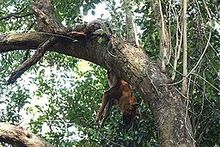
In some areas, dholes are sympatric to tigers and leopards. Competition between these species is mostly avoided through differences in prey selection, although there is still substantial dietary overlap. Along with leopards, dholes typically target animals in the 30–175 kg (66–386 lb) range (mean weights of 35.3 kg [78 lb] for dhole and 23.4 kg [52 lb] for leopard), while tigers selected for prey animals heavier than 176 kg (388 lb) (but their mean prey weight was 65.5 kg [144 lb]). Also, other characteristics of the prey, such as sex, arboreality and aggressiveness, may play a role in prey selection. For example, dholes preferentially select male chital, whereas leopards kill both sexes more evenly (and tigers prefer larger prey altogether), dholes and tigers kill langurs rarely compared to leopards due to the leopards' greater arboreality, while leopards kill wild boar infrequently due to the inability of this relatively light predator to tackle aggressive prey of comparable weight.[12]
Tigers are dangerous opponents for dholes, as they have sufficient strength to kill a dhole with a single paw strike.[20] Dhole packs are smaller in areas with higher tiger densities due to tigers directly killing dholes and stealing kills they made. The kleptoparasitism causes dholes to prefer hunting smaller animals because they can eat more of a smaller carcass before a tiger arrives to steal it. Direct predation can lead to lower reproductive and recruitment rates, lower hunting success rates and less food for the pups when a helper is killed, and potentially pack destabilization if one member of the breeding pair is killed.[116]
Dhole packs may steal leopard kills, while leopards may kill dholes if they encounter them singly or in pairs.[47] There are numerous records of leopards being treed by dholes.[95] Dholes were once thought to be a major factor in reducing Asiatic cheetah populations, though this is doubtful, as cheetahs live in open areas as opposed to forested areas favoured by dholes.[117] Since leopards are smaller than tigers and are more likely to hunt dholes, dhole packs tend to react more aggressively toward them than they do towards tigers.[118]
Dhole packs occasionally attack
The dhole is also sympatric with the Indian wolf (Canis lupus pallipes) in parts of its range.[120][121] There is at least one record of a lone wolf associating with a pair of dholes in Debrigarh Wildlife Sanctuary,[122] and two observations in Satpura Tiger Reserve.[123] They infrequently associate in mixed groups with golden jackals. Domestic dogs may kill dholes, though they will feed alongside them on occasion.[124]
Diseases and parasites
Dholes are vulnerable to a number of different diseases, particularly in areas where they are
Threats
Some ethnic groups like the
Conservation
In India, the dhole is protected under Schedule 2 of the
In 2016, the Korean company Sooam Biotech was reported to be attempting to clone the dhole using dogs as
In culture and literature

Three dhole-like animals are featured on the coping stone of the Bharhut stupa dating from 100 BC. They are shown waiting by a tree, with a woman or spirit trapped up it, a scene reminiscent of dholes treeing tigers.[129] The animal's fearsome reputation in India is reflected by the number of pejorative names it possesses in Hindi, which variously translate as "red devil", "devil dog", "jungle devil", or "hound of Kali".[20]
Dholes appear in Rudyard Kipling's Red Dog, where they are portrayed as aggressive and bloodthirsty animals which descend from the Deccan Plateau into the Seeonee Hills inhabited by Mowgli and his adopted wolf pack to cause carnage among the jungle's denizens. They are described as living in packs numbering hundreds of individuals, and that even Shere Khan and Hathi make way for them when they descend into the jungle. The dholes are despised by the wolves because of their destructiveness, their habit of not living in dens and the hair between their toes. With Mowgli and Kaa's help, the Seeonee wolf pack manages to wipe out the dholes by leading them through bee hives and torrential waters before finishing off the rest in battle.
Japanese author Uchida Roan wrote 犬物語 (Inu monogatari; A dog's tale) in 1901 as a nationalistic critique of the declining popularity of indigenous dog breeds, which he asserted were descended from the dhole.[130]
A fictional version of the dhole, imbued with supernatural abilities, appears in the season 6 episode of TV series The X-Files, titled "Alpha".
In China, the dhole were widely known throughout history and mythology. One notable legendary creature is the Yazi (睚眦), which was believed to be a creature that was part-dhole part-dragon. In modern times, however, the Chinese word for dhole (豺; Chái) is often confused with 'jackal' or 'wolf', resulting in many confusions and mistranslations of dholes as jackals or wolves.[131]
Dholes also appear as enemies in the
Tameability
Brian Houghton Hodgson kept captured dholes in captivity, and found, with the exception of one animal, they remained shy and vicious even after 10 months.[113][132] According to Richard Lydekker, adult dholes are nearly impossible to tame, though pups are docile and can even be allowed to play with domestic dog pups until they reach early adulthood.[17] A dhole may have been presented as a gift to Ibbi-Sin as tribute.[133]
See also
Notes
- ^ For a full set of supporting references refer to the note (a) in the phylotree at Evolution of the wolf#Wolf-like canids
References
- ^ . Retrieved 24 January 2022.
- ^ ""dhole"". Merriam-Webster. Archived from the original on 7 January 2024. Retrieved 7 January 2024.
- ^ ""dhole"". Collins Dictionary. Archived from the original on 1 May 2021. Retrieved 7 January 2024.
- ^ PMID 16341006.
- ^ a b Clutton-Brock, J.; Corbet, G. G. & Hills, M. (1976). "A review of the family Canidae, with a classification by numerical methods". Bulletin of the British Museum of Natural History. 29: 179–180. Archived from the original on 17 December 2013. Retrieved 8 December 2014.
- ^ ISBN 1-886106-81-9.
- S2CID 7476436.
- ^ a b Fox 1984, p. 85
- ^ a b c d Fox 1984, pp. 86–87
- ^ JSTOR 3503800.
- ^ ISBN 978-2831707860. Archived(PDF) from the original on 13 October 2006. Retrieved 31 January 2020.
- ^ JSTOR 5647.
- ^ Williamson, T. (1808). Oriental field sports: being a complete, detailed, and accurate description of the wild sports of the East. Vol. II. London: Orme.
- ^ Smith, C. H. (1827). The class Mammalia. London: Geo. B. Whittaker.
- ^ Smith, C. H.; Jardine, W. (1839). The natural history of dogs: Canidae or genus canis of authors; including also the genera hyaena and proteles. Vol. I. Edinburgh, UK: W.H. Lizars.
- ISBN 978-90-04-12875-0
- ^ a b c d Lydekker, R. (1907). The game animals of India, Burma, Malaya, and Tibet. London, UK: R. Ward Limited.
- ^ dhole Archived 24 December 2016 at the Wayback Machine. Merriam-Webster Dictionary.
- ^ Fox 1984
- ^ a b c d Perry, R. (1964). The World of the Tiger. London: Cassell.
- ^ a b Schrenk, L. v. (1859). "Canis alpinus". Reisen und Forschungen im Amur-lande in den jahren 1854–1856 (in German). St. Petersburg: Kaiserliche Akademie der Wissenschaften. pp. 48–50.
- ^ a b Pallas, P. S. (1811). "Canis alpinus". Zoographia Rosso-Asiatica: Sistens omnium animalium in extenso Imperio Rossico, et adjacentibus maribus observatorum recensionem, domicilia, mores et descriptiones, anatomen atque icones plurimorum (in Latin). Petropoli: In officina Caes. Acadamiae Scientiarum Impress. pp. 34–35.
- ^ a b Heptner, V. G.; Naumov, N. P., eds. (1998). "Red Wolf Cuon alpinus Pallas, 1811". Mammals of the Soviet Union. Vol. II. Washington, DC: Smithsonian Institution and National Science Foundation. Part 1A: Sirenia and Carnivora (Sea Cows, Wolves, and Bears), pp. 571–586.
- ^ Hodgson, B. H. (1833). "Description and Characters of the Wild Dog of the Himalaya (Canis primævus)". Asiatic Researches. XVIII (2): 221–237, 235.
- ^ Hodgson, B. H. (1842). "European notices of Indian canines, with further illustrations of the new genus Cuon vel Chrysæus". Calcutta Journal of Natural History. II: 205–209.
- ^ a b Thenius, E. (1955). "Zur Abstammung der Rotwölfe (Gattung Cuon Hodgson)" [On the origins of the dholes (Genus Cuon Hodgson)] (PDF). Österreichische Zoologische Zeitschrift (in German). 5: 377–388. Archived (PDF) from the original on 10 November 2014.
- ISBN 9781412845144.
- .
- ^ Petrucci, M.; Romiti, S. & Sardella, R. (2012). "The Middle-Late Pleistocene Cuon Hodgson, 1838 (Carnivora, Canidae) from Italy" (PDF). Bollettino della Società Paleontologica Italiana. 51 (2): 146. Archived (PDF) from the original on 2 January 2015.
- ^ PMID 33499169.
- ISBN 9780801880322.
- ^ Cranbrook, E. (1988). "The contribution of archaeology to the zoogeography of Borneo : with the first record of a wild canid of Early Holocene Age ; a contribution in celebration of the distinguished scholarship of Robert F. Inger on the occasion of his sixty-fifth birthday". Fieldiana Zoology. 42: 6–24.
- S2CID 55862985.
- ISBN 9781107729131. Archivedfrom the original on 15 April 2021. Retrieved 29 July 2016.
- ISBN 978-0-5213-5505-6. Archivedfrom the original on 3 February 2021. Retrieved 30 August 2015.
- from the original on 3 March 2024. Retrieved 29 July 2021.
- S2CID 53691225.
- ^ PMID 31679488.
- ^ "疑豺、狼化石 大甲溪床現蹤" [Suspected dhole and wolf fossils found in the bed of Dajia River]. Taiwan Geoscience Portal (in Chinese). October 2009. Archived from the original on 22 April 2023. Retrieved 1 September 2022.
- ISSN 0003-0090.
- from the original on 24 September 2015. Retrieved 16 January 2024 – via Elsevier Science Direct.
- hdl:2246/1104.
- doi:10.1016/j.anthro.2006.10.001. Archived from the originalon 14 March 2012. Retrieved 30 July 2017. (in French)
- .
- S2CID 17083040.
- ISBN 9780231509435.
- ^ a b c d e f g h Pocock, R. I. (1941). "Genus Cuon Hodgs.". Fauna of British India: Mammals. Vol. 2. Taylor & Francis. pp. 146–163.
- ^ S2CID 238996621.
- PMID 30344120.
- ^ Ellerman, J.R.; Morrison-Scott, T.C.S. (1966). Checklist of Palaearctic and Indian mammals. London, UK: British Museum (Natural History).
- ISBN 978-0-8018-8221-0. Archivedfrom the original on 3 March 2024. Retrieved 3 March 2024.
- ^ Orrell T (2020). Nicolson D, Roskov Y, Abucay L, Orrell T, Nicolson D, Bailly N, Kirk PM, Bourgoin T, DeWalt RE, Decock W, De Wever A, van Nieukerken E, Zarucchi J, Penev L (eds.). "Cuon alpinus (Pallas, 1811) (accepted name)". Catalogue of Life: 2019 Annual Checklist. Catalogue of Life. Archived from the original on 6 February 2020. Retrieved 5 February 2020.
- ^ "Dhole | Canids". canids.org. Archived from the original on 23 September 2021.
- (PDF) from the original on 7 March 2020.
- .
- ^ .
- ^ Афанасьев, А.В.; Золотарев, Н.Т. (1935). "Новые данные по систематике и распространению красного волка" [Contribution to the systematics and distribution of red wolf]. Известия Академии наук СССР. VII Отделение математических и естественных наук (in Russian) (3): 425–429. Archived from the original on 3 March 2024. Retrieved 27 July 2021.
- ^ Heude, Mém. Hist. Nat. Empire Chinois, II, pt2, p. 102 footnote 1892
- ISBN 978-0-691-18372-5. Archivedfrom the original on 14 June 2021. Retrieved 14 June 2021.
- ^ Hardwicke, T. (1821). "Descriptions of the Wild Dog of Sumatra, a new Species of Viverra, and a new Species of Pheasant". Transactions of the Linnean Society of London. 3: 235–238. Archived from the original on 23 October 2023. Retrieved 3 March 2024.
- .
- ^ Fox 1984, pp. 61–2
- ^ Fox 1984, pp. 41
- S2CID 54996917.
- ^ a b Cancellare, I.A.; Kachel, S.M.; Kubanychbekov, Z.; Kulenbekov, R.; Pilgrim, K.L.; McCarthy, K.P. & Weckworth, B.V. (2022). "New distribution record of dhole from southern Kyrgyzstan using non-invasive genetic sampling" (PDF). Canid Biology & Conservation. 24 (1): 1–3. Archived (PDF) from the original on 2 February 2022. Retrieved 22 February 2022.
- ^ Williams, M. & Troitskaya, N. (2007). "Then and Now: Updates from Russia's Imperiled Zapovedniks" (PDF). Russian Conservation News. 42: 14. Archived (PDF) from the original on 28 January 2012.
- ^ Newell, J. (2004). The Russian Far East: A Reference Guide for Conservation and Development (Second ed.). McKinleyville: Daniel & Daniel.
- ^ S2CID 20037994.
- ^ Harris, R. B. (2006). "Attempted predation on blue sheep Pseudois nayaur by dholes Cuon alpinus". Journal of the Bombay Natural History Society. 103: 95–97.
- from the original on 3 March 2024. Retrieved 19 December 2017.
- S2CID 16752357.
- S2CID 5273403.
- ^ Canid and Hyaenid Taxon Advisory Group (2017). Best Practice Guideline Dhole (C. alpinus) (PDF). Amsterdam: European Association of Zoos and Aquaria. Archived (PDF) from the original on 6 February 2020.
- ^ Kao, J., N. Songsasen, K. Ferraz and K. Traylor-Holzer (Eds.) (2020). Range-wide Population and Habitat Viability Assessment for the Dhole, Cuon alpinus. IUCN SSC Conservation Planning Specialist Group, Apple Valley, MN, USA. p8. https://www.canids.org/resources/Dhole_PHVA_Report_2020.pdf Archived 6 June 2020 at the Wayback Machine
- ^ Thapa, K.; Kelly, M. J.; Karki, J. B. & Subedi, N. (2013). "First camera trap record of pack hunting dholes in Chitwan National Park, Nepal" (PDF). Canid Biology & Conservation. 16 (2): 4–7. Archived (PDF) from the original on 21 December 2014.
- from the original on 22 September 2017. Retrieved 20 April 2018.
- ^ Parmar, Vijaysinh (23 May 2020). "Rare whistling dogs spotted in Gujarat after 50 years". The Times of India. Archived from the original on 1 June 2020. Retrieved 1 June 2020.
- ^ Wangchuk, T. (2004). "Predator-prey dynamics: the role of predators in the control of problem species" (PDF). Journal of Bhutan Studies. 10: 68–89. Archived (PDF) from the original on 24 February 2015.
- .
- TheGuardian.com. March 2016. Archivedfrom the original on 29 July 2020. Retrieved 6 June 2020.
- .
- ^ "Sumatran secrets start to be revealed by high altitude camera trapping". Flora and Fauna International. Archived from the original on 1 May 2017. Retrieved 5 September 2015.
- ^ Jenks, K. E.; Songsasen, N. & P. Leimgruber (2012). "Camera trap records of dholes in Khao Ang Rue Nai Wildlife Sanctuary, Thailand" (PDF). Canid News: 1–5. Archived (PDF) from the original on 21 December 2014.
- S2CID 54996917.
- S2CID 202920288.
- S2CID 198272874.
- ^ Serez, M. & Eroðlu, M. (1994). "A new threatened wolf species, Cuon alpinus hesperius Afanasiev and Zolatarev, 1935 in Turkey". Council of Europe Environmental Encounters Series. 17: 103–106.
- ^ Khatukhov, A.M. (2015). "Красный волк (Cuon alpinus Pallas, 1811) на Центральном Кавказе" [The Dhole (Cuon alpinus Pallas 1811) in the Central Caucasus] (PDF). Современные проблемы науки и образования. 3: 574–581. Archived (PDF) from the original on 8 December 2015.
- ^ "NMNHS expedition went on the trail of an unknown population of the rare dhole in Turkey". National Museum of Natural History, Sofia (NMNHS). 2015. Archived from the original on 9 September 2015. Retrieved 4 September 2015.
- ^ Coel, C. (2015). "[UPDATE] Strongly endangered and undescribed subspecies of dhole discovered? Dhole NOT less endangered than previously thought, according to NMNHS (Bulgaria)". Consortium of European Taxonomic Facilities. Archived from the original on 8 December 2015. Retrieved 15 October 2015.
- ^ Fox 1984, p. 93
- ^ Fox 1984, p. 95
- ^ a b Fox 1984, p. 97
- ^ Fox 1984, pp. 81–2
- ^ a b c d e f Walker, E. P.; Nowak, R. M. & Warnick, F. (1983). Walker's Mammals of the World (Fourth ed.). Baltimore: Johns Hopkins University Press.
- ^ Fox 1984, p. 92
- ^ Keller, R. (1973). "Einige beobachtungen zum verhalten des Dekkan-Rothundes (Cuon alpinus dukhunensis Sykes) im Kanha National Park" [Some observations on the behavior of the Deccan Red Dog (Cuon alpinus dukhunensis Sykes) in Kanha National Park] (PDF). Vierteljahresschrift. Naturf. Ges. Zürich (in German). 118: 129–135. Archived (PDF) from the original on 12 August 2019.
- ^ Fox 1984, pp. 43–49
- ^ a b Fox 1984, p. 80
- ^ Fox 1984, p. 79
- PMID 28852505.
- ^ Fox 1984, pp. 100–101
- ^ Fox 1984, p. 50
- ^ Fox 1984, p. 73
- ^ Fox 1984, p. 67
- ^ Fox 1984, p. 61
- S2CID 85198149. Archived from the originalon 23 November 2006.
- ^ Fox 1984, p. 63
- ^ Fox 1984, p. 70
- ^ Fox 1984, p. 51
- ^ Fox 1984, pp. 58–60
- ^ Chacon, Raquel. "Cuon alpinus (dhole)". Animal Diversity Web. Archived from the original on 27 January 2023. Retrieved 4 April 2023.
- ^ a b c Mivart, G. (1890). "Genus Cyon, Hodgson (1838)". Dogs, Jackals, Wolves and Foxes: A Monograph of the Canidæ. London: R.H. Porter. pp. 177–188.
- ^ Fox 1984, p. 71
- ^ Johnsingh, A.J.T.; Yonten, D.; Wangchuck, S. (2007). "Livestock-Dhole Conflict in Western Bhutan". Journal of the Bombay Natural History Society. 104 (2): 201–202 – via Biodiversity Heritage Library.
- PMID 33976847.
- ^ Finn, F. (1929). Sterndale's Mammalia of India. London: Thacker, Spink & Co.
- ^ Venkataraman, A. (1995). "Do dholes (Cuon alpinus) live in packs in response to competition with or predation by large cats?" (PDF). Current Science. 69 (11): 934–936. Archived (PDF) from the original on 13 July 2019.
- ISBN 978-0-9524390-6-6.
- S2CID 24051254.
- .
- ^ Nair M. V. & Panda S. K. (2013). "Just Friends". Sanctuary Asia. XXXIII: 3. Archived from the original on 24 July 2019. Retrieved 23 December 2014.
- ^ Ghaskadbi, P.; Das, J.; Mahadev, V. & Habib, B. (2021). "First record of mixed species association between dholes and a wolf from Satpura Tiger Reserve, India" (PDF). Canid Biology & Conservation. 23 (4): 15–17. Archived (PDF) from the original on 17 October 2021.
- ISBN 978-1-877743-07-8.
- PMID 34385570.
- ^ Fox 1984, p. 109
- ^ Zoo to have conservation breeding centre for ‘dhole’ Archived 3 March 2024 at the Wayback Machine, The Hindu (18 August 2014)
- ^ Zastrow, M. (8 February 2016). "Inside the cloning factory that creates 500 new animals a day". New Scientist. Archived from the original on 22 February 2016. Retrieved 23 February 2016.
- ISBN 90-04-16819-2
- ISBN 0801463246
- JSTOR 41645459.
- ^ Hodgson, B.H. (1833). "Description of the Wild Dog of the Himalaya". Asiatic Researches. XVIII: 226. Archived from the original on 29 January 2021. Retrieved 14 January 2021.
- ISBN 1-57607-907-4
Bibliography
- Fox, M.W. (1984). The Whistling Hunters: Field Studies of the Asiatic Wild Dog (Cuon alpinus). Albany: State University of New York Press. ISBN 978-0-9524390-6-6.
- Karanth, U.K. (2006). A View From the Machan. Karnataka: Permanent Black. ISBN 978-8-1782413-7-1.
External links
- Dhole Home Page (Archive)
- ARKive – images and movies of the dhole
- Saving the dhole: The forgotten 'badass' Asian dog more endangered than tigers, The Guardian (25 June 2015)
- Photos of dhole in Bandipur


